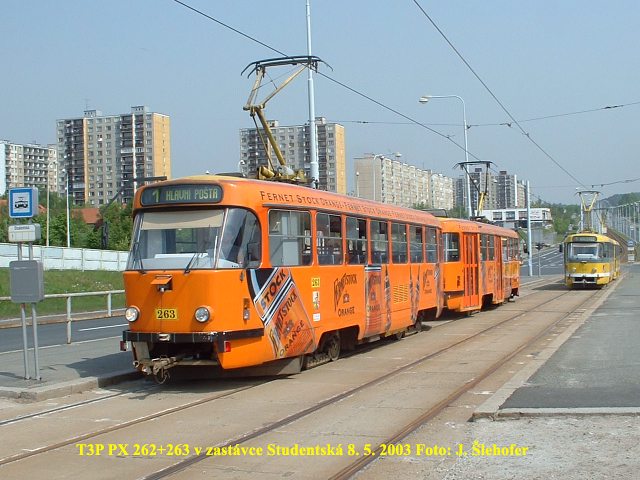An operational question for North Americans. In an edition of Transit Australia from last year there was an article by Tony Prescott where he argues for unidirectional running, he has this idea of tram going only one way, with a driver's cab at only the front, doors on only one side and using loop track to turn around. His article is about why some European systems stick to unidirectional running and why many newcomers to LRT are so reluctant to consider it.
I have noticed that the Portland streetcar line is basically a single track loop, with streetcars running continuously in the same direction. Yet their rolling stock is all designed for bidirectional running, because they started with dead end termini. There is some discussion on skyscraper city. A poster from Syndey, New South Wales, Australia wanted to know whether Czech tram operators have had any significant problems with operating unidirectional trams and what the experience was like over the years. Someone else replied that bidirectional system were not considered necessary and there were not siginificant problems. Larger systems like Prague have small bidirectional fleets which can be used on lines temporarily truncated for trackwork, and others couple unidirectional trams back to back.
As for US streetcar operations, knowing that Boston and Philadelphia use unidirectional LRVs quite extensively. Have cities like Philidelphia ever considered switching to bidirectional running or are they happy with the way things are? Unidirectional running was historically common in North America and did all those old systems run into significant problems.
If you have a driver's cab at only the front and doors on only the right, there will be more seats and most fixed front facing. Here in Australia, according to that aforementioned Australian poster on skyscraper city, many public transport users also do not like facing each other, so Sydney trains often have flip over seating, but trams here in Melbourne and those of the Sydney light rail, and all new trams in Adelaide have half the seats facing each way. Some old trams here, such as the Adelaide H class and the Y class Melbourne tram had flip over seats. Is there is same problem in North America with traveling backwards, and do reversible seats have any history in North America?
A case that comes to mind is Washington DC, it appears that their new system will use bidirectional trams and dead end termini despite the fact that their previous system, many surviving unidirectional networks show no signs of converting to bidirectional running, and the supplier, Skoda, supplies mostly unidirectional rolling stock. Does Washington have any island platforms or is it side platforms only? Note that staggered side platforms can take up less lateral space than island platforms, and on narrower roads, stops are necessarily on the kerbside.
And even if you operate bidirectional rolling stock, you may need loops at busy termini because there is often not enough time to change ends, and even if there is only just enough, what happens if the driver discovers a hidden fault.
I have noticed that the Portland streetcar line is basically a single track loop, with streetcars running continuously in the same direction. Yet their rolling stock is all designed for bidirectional running, because they started with dead end termini. There is some discussion on skyscraper city. A poster from Syndey, New South Wales, Australia wanted to know whether Czech tram operators have had any significant problems with operating unidirectional trams and what the experience was like over the years. Someone else replied that bidirectional system were not considered necessary and there were not siginificant problems. Larger systems like Prague have small bidirectional fleets which can be used on lines temporarily truncated for trackwork, and others couple unidirectional trams back to back.
As for US streetcar operations, knowing that Boston and Philadelphia use unidirectional LRVs quite extensively. Have cities like Philidelphia ever considered switching to bidirectional running or are they happy with the way things are? Unidirectional running was historically common in North America and did all those old systems run into significant problems.
If you have a driver's cab at only the front and doors on only the right, there will be more seats and most fixed front facing. Here in Australia, according to that aforementioned Australian poster on skyscraper city, many public transport users also do not like facing each other, so Sydney trains often have flip over seating, but trams here in Melbourne and those of the Sydney light rail, and all new trams in Adelaide have half the seats facing each way. Some old trams here, such as the Adelaide H class and the Y class Melbourne tram had flip over seats. Is there is same problem in North America with traveling backwards, and do reversible seats have any history in North America?
A case that comes to mind is Washington DC, it appears that their new system will use bidirectional trams and dead end termini despite the fact that their previous system, many surviving unidirectional networks show no signs of converting to bidirectional running, and the supplier, Skoda, supplies mostly unidirectional rolling stock. Does Washington have any island platforms or is it side platforms only? Note that staggered side platforms can take up less lateral space than island platforms, and on narrower roads, stops are necessarily on the kerbside.
And even if you operate bidirectional rolling stock, you may need loops at busy termini because there is often not enough time to change ends, and even if there is only just enough, what happens if the driver discovers a hidden fault.
Also known as Myrtonos
